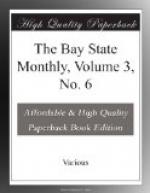REBECCA NURSE, YARMOUTH, ENGLAND, 1621. SALEM, MASS., 1692.
O Christian martyr, who for Truth could
die
When all about thee owned the hideous
lie,
The world, redeemed from Superstition’s
sway,
Is breathing freer for thy sake to-day.
I lingered a moment over these fitting lines of Whittier, whose charming home, “Oak Knoll,” a short distance off, had just given me a restful pleasure. Then I walked around to the other side of the monument, where I read, with mingled feelings, the following words:—
Accused of witchcraft
She declared,
“I am innocent, and God will
clear my innocency.”
Once acquitted yet falsely
condemned, she suffered
death July 19, 1692.
In loving memory of her
Christian character,
even then truly attested by
forty of her neighbors,
this monument is erected.
These last lines reminded me of the fact that the paper with its forty signatures, testifying to the forty years’ acquaintance of the good character of Rebecca Nurse, was still in existence. Alas! why couldn’t such a testimony of neighbors and friends have saved her? But it was not so to be. The government of the colony, the influence of the magistracy, and public opinion elsewhere, overpowered all friendly and family help; and on the 19th July, 1692, at the advanced age of seventy-one years, Rebecca Nurse was hung on Gallows hill.
As I left the monument, which is in the old family burying-ground, and wandered up the time-honored lane towards the homestead where she was living when arrested, the March before, my thoughts would go back to those dreadful days. I thought of this venerable mother’s surprise and wonder, as she learned of the several distinct indictments against her, four of which, for having practised “certain detestable acts called witchcraft” upon Ann Putnam, Mary Walcot, Elizabeth Hubbard, and Abigail Williams, were still to be found in the Salem records. I thought of the feelings of this old and feeble woman as she was borne to the Salem jail, then a month later sent off, with other prisoners, to the jail in Boston (then a whole day’s journey), to be sent back to Salem for her final doom. I pictured her on trial, when, in the presence of her accusers, the “afflicted girls,” and the assembled crowd, she constantly declared her innocence ("I am innocent, and God will clear my innocency"), and showed a remarkable power in refuting the questions of the magistrate. I thought of her Christian faith and courage, when, upon seeing all the assembly, and even the magistrate, putting faith in the “afflicted girls’” diabolical tantrums (what else can I call them?) as there enacted, and now preserved in the records of the trial, she calmiy said, “I have got nobody to look to but God.” I again pictured her, as, just before the horrors of execution, she was taken from the prison to the meeting-house, by the sheriff and his men, to receive before a great crowd of spectators the added disgrace of excommunication from the Church.




